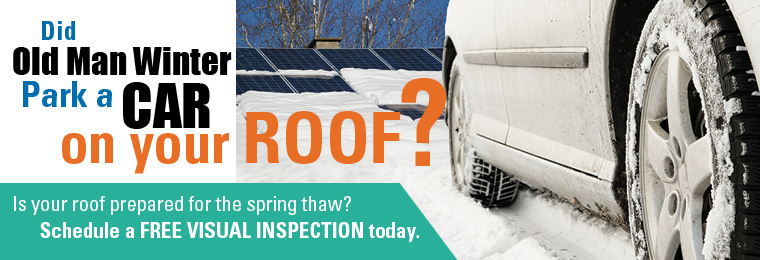Did Old Man Winter Park a Car on Your Roof?
3/3/2015
As winter moves into spring, melted snow often collects on a roof, causing serious damage. Leaks are an obvious problem, but ponded water is deceptively heavy. Just three inches of water on a 30’ x 30’ section weighs over 14,000 pounds – the equivalent of more than three cars! All that moisture and weight on your roof could lead to expensive, time-consuming repairs.
Ready Your Roof for the Spring Thaw
Moisture is a roof’s #1 enemy. It can ruin the insulation, cause mildew, rot decking and even damage the structure. An experienced roofing professional, such as a Tremco Roofing field advisor, should inspect roofing systems at least twice per year, preferably in the spring and fall. Routine inspections help avoid costly and time-consuming repairs from damage or water infiltration that can accelerate the aging and deteriorating of a roofing system.

Spring Forward with a Tremco Roofing Visual Inspection
Spring is the perfect time to bring your facility up to watertight standards. Tremco Roofing’s free visual inspection examines your roof for surface issues, such as damaged counterflashings, split membranes, clogged drains and open pitch pans.
Probe Deeper with Tremco Roofing Diagnostics
Our visual inspection often uncovers more complex, insidious issues beneath the surface that would have otherwise gone undetected. In these cases, Tremco Roofing offers a variety of high-tech diagnostic tools that allow us to pinpoint the source and extent of a roof’s issues:
- Infrared Scan
Wet roof insulation absorbs more solar energy than dry roof insulation, retaining the heat even after the roof surface cools. An infrared scan, performed at night, locates hidden moisture within a roof’s insulation by detecting and recording variances in temperature on a detailed thermal map. Infrared scans are recommended for smooth roof surfaces without thick gravel or ballasts.
- Core Analysis
Core analysis, used in conjunction with an infrared scan, involves cutting out a small portion of the roof and measuring the amount of moisture in its core components, such as the insulation, deck, membrane and bitumen types. All roof cores are immediately repaired to ensure waterproofing continuity.
- Nuclear Gauge Survey
A nuclear gauge survey can detect moisture as deep as eight inches into the roofing system – not just in the first layer of insulation. A technician marks a grid pattern, and then uses a nuclear gauge to emit neutrons into the roof and take readings at each grid intersection. If moisture is present, hydrogen slows the neutrons, which is detected by the nuclear gauge. Nuclear gauge surveys can be performed during the day and even in inclement weather, and are recommended for heavily graveled, ballasted or retrofitted roofing systems.
- Capacitance Test
A capacitance test identifies water entry pathways and areas of trapped water within a roofing system by measuring stored electrical energy. This involves placing a moisture meter on a roof’s surface and sending a safe electrical charge into the roof without penetrating the roof membrane. If moisture is present, a higher meter reading will be produced.
Once we determine the source and extent of your roof’s issues, we will develop a long-term plan to help you repair any damage, prepare for capital improvements, reduce costs and extend the life-cycle of your buildings.

Schedule a Free Visual Inspection Today
Schedule a free visual inspection with one of our roofing professionals today. Let Tremco Roofing help you spring forward and protect your roof before water infiltration or other damage occurs. Plus, learn more about our diagnostic testing and comprehensive roof and building envelope management services. For more information, contact Kristen Weiss at 877-432-1132.
